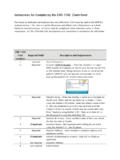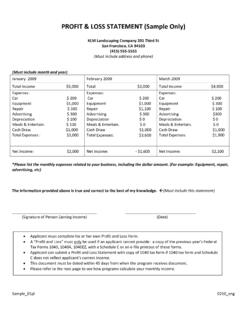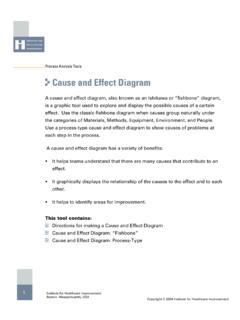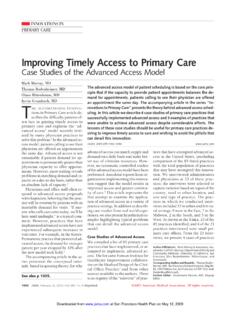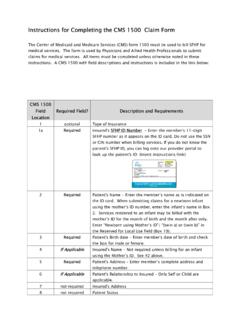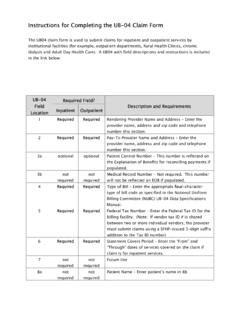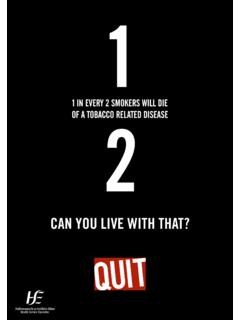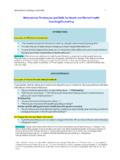Transcription of Counseling Your Patients about Tobacco …
1 Counseling your Patients about Tobacco Cessation: The 5A s Adapted from American Congress of Obstetricians and Gynecologists, The First Method: The 5A's - For Those Ready to Quit , available at When Counseling your Patients about smoking, the Agency for Healthcare Research recommends a brief smoking cessation intervention known as the "5 A s": Ask, Advise, Assess, Assist, and Arrange. This entire Counseling process takes less than three minutes. Clinical judgment is most important when Counseling Patients . The following scripts are examples to address smoking cessation while using the 5A s: ASK Ensure that Tobacco -use status is obtained and recorded at every patient visit.
2 When possible, ask open-ended questions so the patient will have an opportunity to elaborate. The scripts below will help you initiate the conversation. Have you ever smoked? How often do you smoke? When is the last time you smoked? How many cigarettes did you smoke yesterday/last week/last month? Why do you think it would be a good idea to quit? Do you dip or use snuff? ADVISE Advise your Patients to quit smoking. Use clear, strong and personalized language to get your point across. quitting is the single most important thing you can do to protect your health aswell as your family.
3 The effects of your secondhand smoke are harmful to your family. I suggest youquit not only for them but for yourself. Smokers who quit save an average of $120 a month. ASSESS Ask every patient if she is willing to quit at this time. If she is willing to quit, offer praise and provide resources and assistance. If unwilling to quit, help motivate the patient by using the 5 R s : Relevance, Risks, Rewards, Roadblocks, and Repetition. Find out more about the 5 R s in the Clinical Practice Guideline, Treating Tobacco Use and Dependence: 2008 Update (SDL # 11-007), available at If they have tried to quit in the past, get more information.
4 So you ve tried to quit. What do you think triggered you to start smoking again? ASSIST Assist your Patients with a quit plan. Give advice on successful quitting . It is best if you refrain from drinking alcohol at the beginning of your effort to quitsmoking as alcohol is strongly associated with relapse. I suggest you ask others not to smoke in the house while you are trying to quitas it may hinder your success. Provide resources for your patient. If you feel you need more support to help you quit, here is a list of supportgroups in our area. Let me give you some education materials on the benefits of not smoking thatwill help make quitting easier.
5 There are some great resources on the internet that can help you with is a list of websites I recommend. For further assistance with quitting , call the California Smokers Helpline at 1-800-NO-BUTTS. The Quitline will also connect you with local resources that can help you quit. If you are a Medi-Cal member, you can call 1-800-NO-BUTTS to ask about freenicotine patches and a $20 gift card. Assist your patient to quit by setting a quit date, ideally within 2 weeks of the visit. Together, we will set a date that will be scheduled as your last day of about next Monday?
6 When do you think would be a good time for you to quit? Have the patient arrange support from family, friends and co-workers. Do you have friends or family you can call if you get an urge? If you have the urge to smoke, you can call the California Smokers Helpline at1- 800-NO-BUTTS. There are counselors on call Monday through Friday from7am to 9pm and Saturday and Sunday from 9am to 4pm to help you. ARRANGE Schedule follow-up visits/phone calls to review patient progress toward quitting . Teachable Moments Adapted from American Academy of Family Physicians, Treating Tobacco Dependence Pratice Manual, available at Capitalize on teachable moments to discuss healthy lifestyle choices.
7 A teachable moment is the moment that motivates individuals to adopt health behaviors that lower their risk. Some key teachable moment opportunities include: New patient visits Annual physicals Well-child visits (discuss smoking in the home and car) Women s wellness exams Problem-oriented office visits for the many diseases caused or affected bytobacco use and/or exposure to secondhand smoke (upper respiratoryconditions, diabetes, hypertension, asthma, etc.) Follow-up visits after hospitalization for a Tobacco -related illness or the birth ofa child A recent health scareBuild teachable moment reminders into flow sheets and EHR templates for annual exams and Tobacco -affected conditions, so conversations about quitting become a routine part of clinical care.
8 See the Guide to Integrating Tobacco Cessation into Electronic Health Records at A major component to any conversation is assessing Patients attitudes toward and readiness to change. As you capitalize on teachable moments, actively engage Patients in conversations to: Build a dialogue. Bring about a desire for behavior change and eliminate resistance to change. Help Patients set goals that are specific, measurable, attainable, realistic, andtime-referenced (SMART). Improve continuity of Provider Trainings and Resources: Agency for Healthcare Research and Quality's overview of the 5 A s: American College of Obstetricians and Gynecologists, Smoking Cessation During Pregnancy: A Clinician s Guide to Helping Pregnant Women Quit Smoking offers detailed information on implementing the 5 A s with pregnant women.
9 Clinical Practice Guideline, Treating Tobacco Use and Dependence: 2008 Update has extensive information on the 5 A s: Improving Chronic Illness Care, 5 A s Behavior Change Model, Adapted for Self-Management Support Improvement.
